
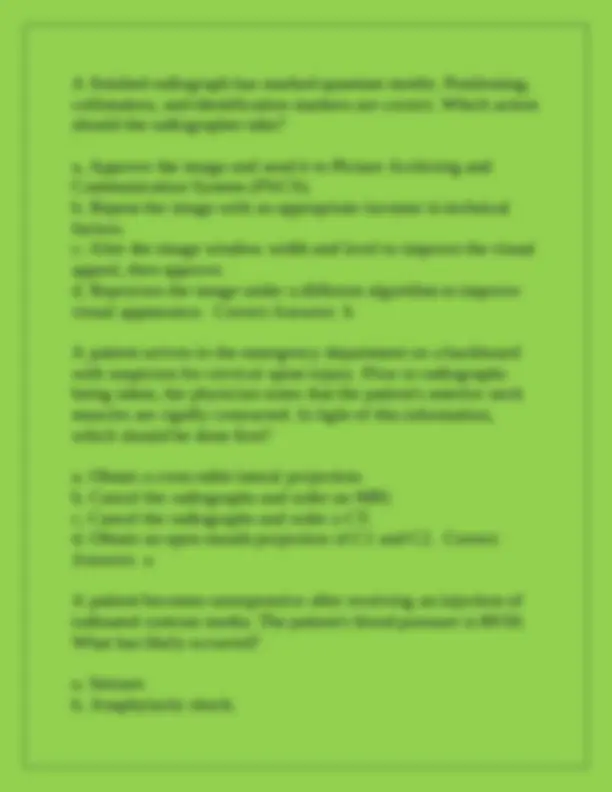








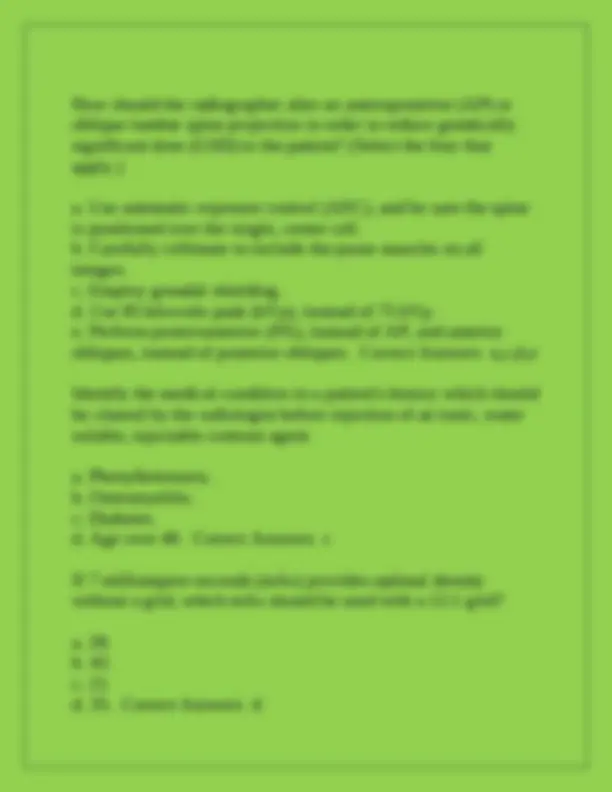


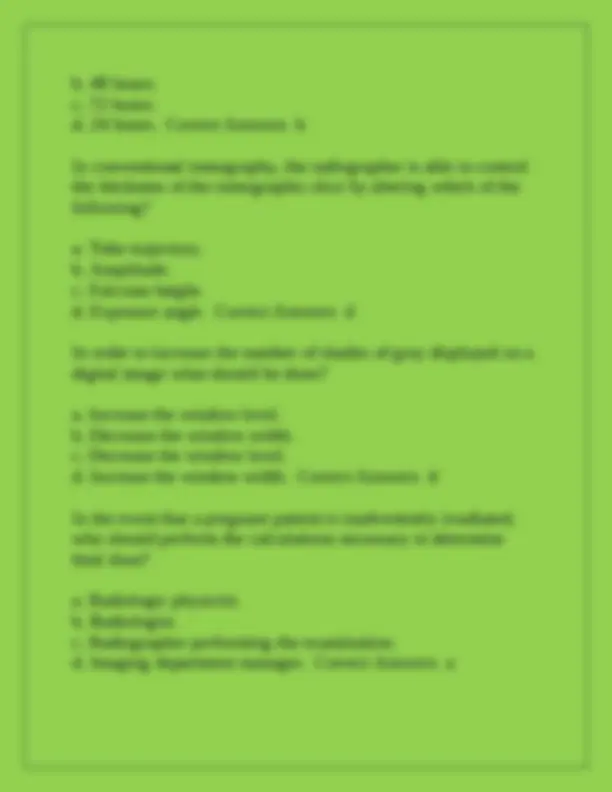













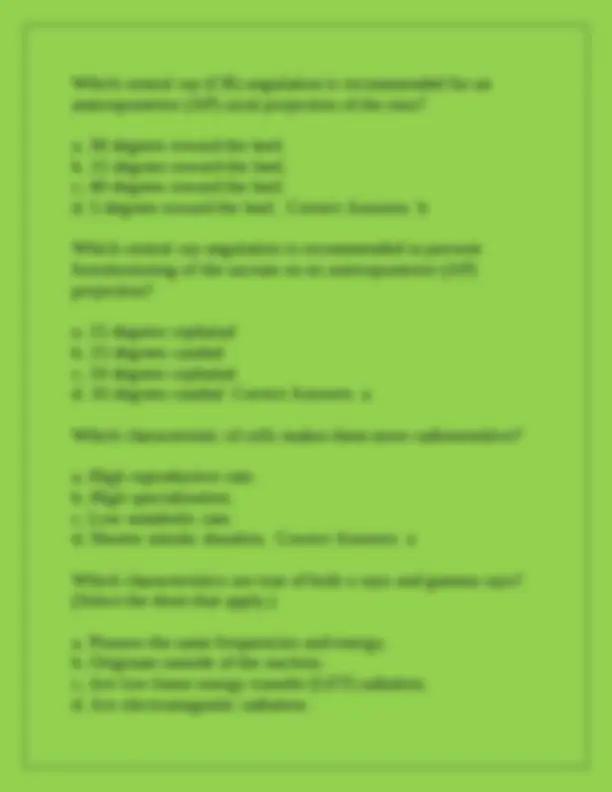
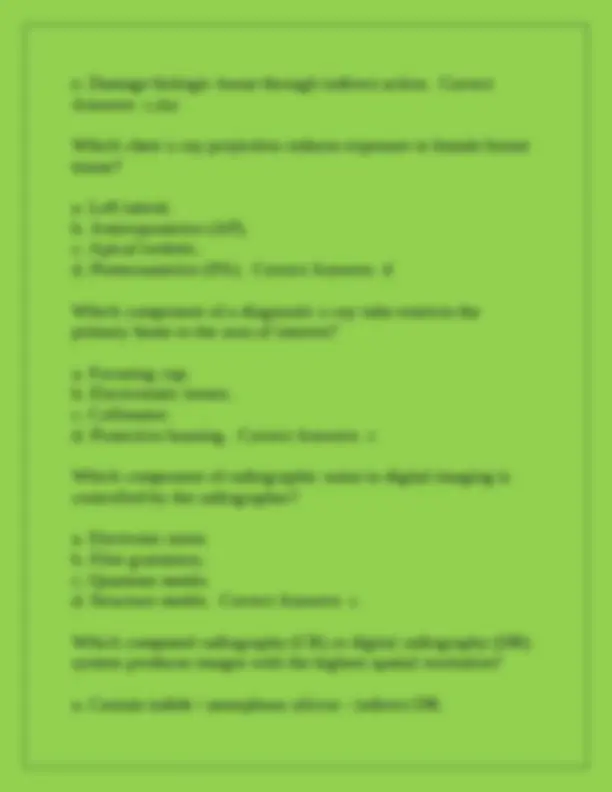

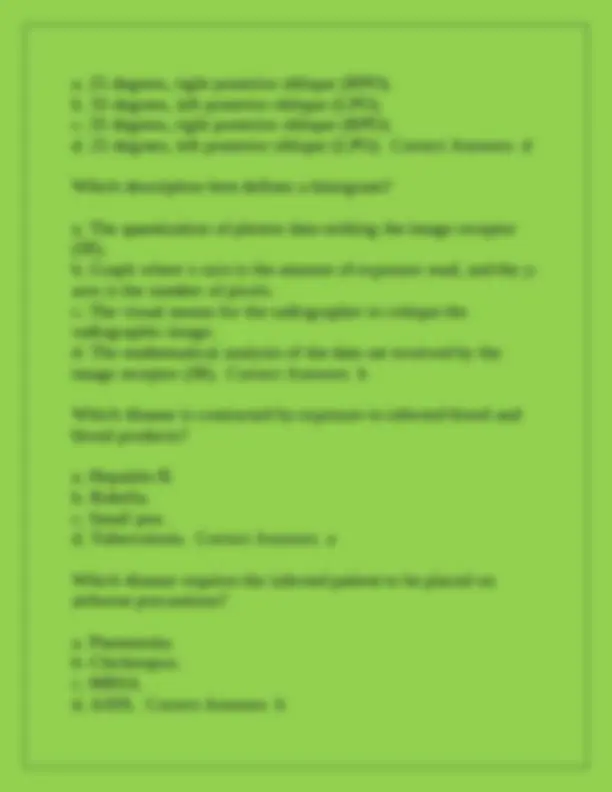
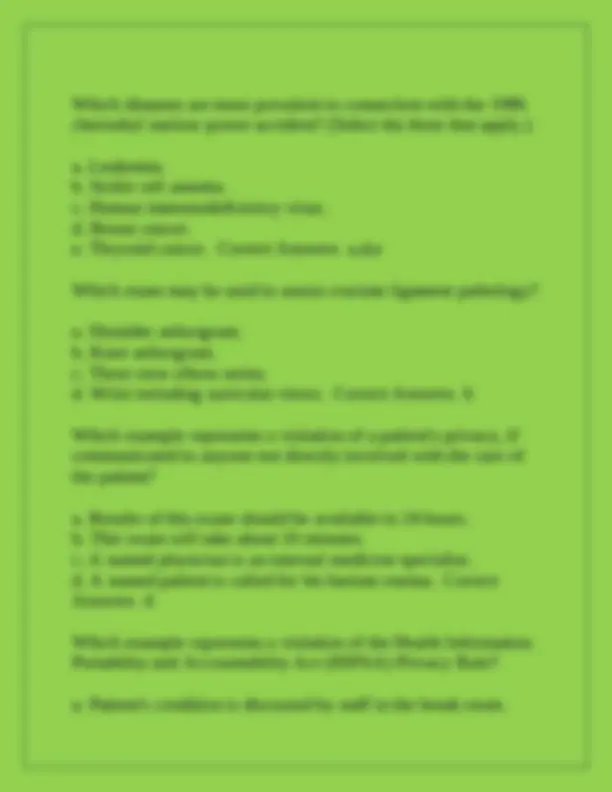
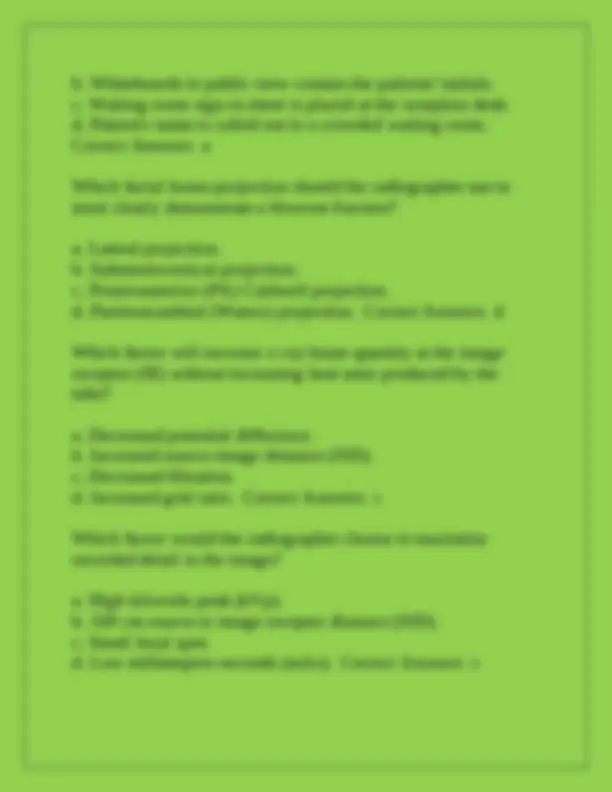



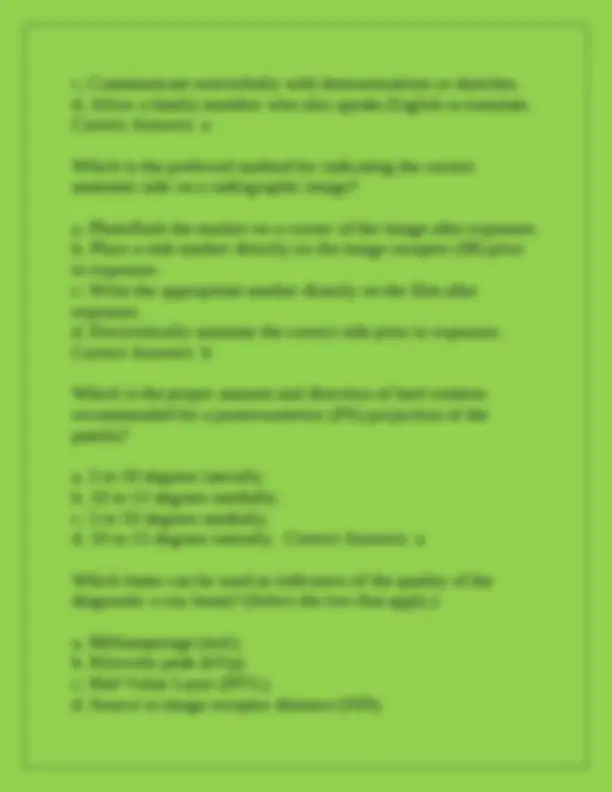
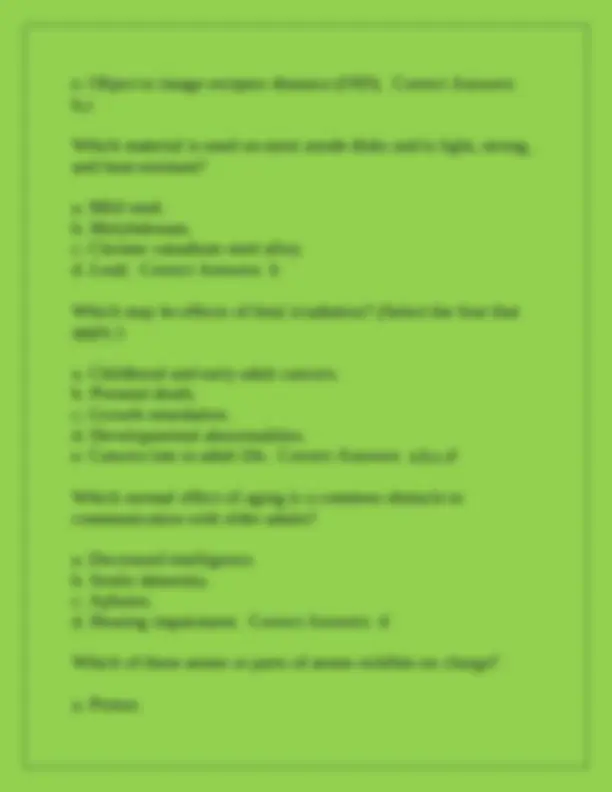













Study with the several resources on Docsity

Earn points by helping other students or get them with a premium plan


Prepare for your exams
Study with the several resources on Docsity

Earn points to download
Earn points by helping other students or get them with a premium plan
Community
Ask the community for help and clear up your study doubts
Discover the best universities in your country according to Docsity users
Free resources
Download our free guides on studying techniques, anxiety management strategies, and thesis advice from Docsity tutors
Comprehensive Radiology Practice Test V2 Questions With Complete Solutions
Typology: Exams
1 / 56

This page cannot be seen from the preview
Don't miss anything!

















































Comprehensive Radiology Practice Test V2 Questions With Complete Solutions A 30-year-old male was exposed to a large amount of radiation in an accident last week; he experienced general malaise, diarrhea, nausea, and vomiting 2 days after the initial exposure, but now feels fine and reports the symptoms have subsided. The patient's presentation is mimicking which stage of acute radiation syndrome (ARS)? a. Prodromal. b. Latent. c. Recovery. d. Manifest. Correct Answers b A 41-year-old male is having a radiographic procedures performed. The patient asks the radiographer, '"What kind of radiation protection policy do you have in place for your patients?" How should the radiographer respond? a. Radiology equipment doesn't really produce radiation. b. We use the "as low as reasonably achievable" (ALARA) philosophy. c. We use film badges to determine the amount of radiation that is reasonable for our patients. d. We use protective aprons to block radiation, so we don't have a policy in place. Correct Answers b A 49-year-old female was referred for mammography, but she is very apprehensive after reading about the risk of ionizing radiation. How should the radiographer handle this situation?
a. Reassure her that the benefit of the procedure outweighs the potential consequences. b. Tell her breast cancer is detrimental to one's health and the procedure is imperative. c. Inform her that shielding will block any bad radiation. d. Advise her there is no such thing as "ionizing radiation" and continue with the procedure. Correct Answers a A 9-year-old has just fallen off the monkey bars. She has obvious deformity to her mid forearm. How should the radiographer care for her when taking x-rays? a. Remove any immobilization devices. b. Support the joints above and below the deformity. c. Nothing, let her move her own arm. d. Move the arm any way needed. Correct Answers b A breathing technique is planned for a right anterior oblique (RAO) sternum radiograph. The intended exposure is 50 milliampere-seconds (mAs) at 75 kilovolts peak (kVp) at 100 centimeter source to image receptor distance (SID). Which milliampere (mA) station is preferred, assuming the radiographer ensures exposure occurs during the act of inspiration? a. 100. b. 10. c. 50. d. 25. Correct Answers c
c. Syncopal episode. d. Insulin shock. Correct Answers b A patient is having a lengthy procedure done in the medical imaging department. The patient seemed to be anxious at the beginning of the procedure and starts wheezing. What should the radiographer do next? a. Call for medical assistance. b. Initiate oxygen therapy. c. Ask the patient if they have a history of asthma. d. Allow the patient to use an inhaler. Correct Answers c A patient is scheduled for a voiding cystourethrogram (VCUG). The radiographer explains the procedure in these terms: "This tubing will be connected to your catheter. It's very important that the bladder gets very full, so please let us know when you feel the urge to urinate." For which patient is this explanation most appropriate? a. 6-year-old child. b. 24-year-old woman. c. 6-month-old baby. d. 2-year-old child. Correct Answers b A patient is scheduled for an interventional radiological procedure that requires general anesthesia. Who is the most appropriate person to obtain informed consent for the procedure in this situation? a. Radiographer.
b. Anesthesiologist. c. Radiologist. d. Interventional nurse. Correct Answers c A patient receives an entrance skin dose of 5 mGy during a lumbar spine procedure. How much exposure will the radiographer receive when standing 1 meter from the patient? a. 0.015 mGy. b. 0.005 mGy. c. 0.01 mGy. d. 0.025 mGy. Correct Answers b A patient with a history of stroke and hemi-paralysis is transported to the x-ray department by wheelchair. Which action should be first taken by the radiographer? a. Place the patient's strong side next to the table. b. Brace the weak leg as the patient stands. c. Stand behind the patient during the transfer. d. Instruct the patient to lead with his strong leg. Correct Answers a A patient with a wound infection caused by methicillin resistant staphylococcus aureus (MRSA) should be placed under which type of precaution? a. Airborne. b. Droplet. c. Contact.
A radiographer critiques an anteroposterior (AP) image of the ribs. The left sternoclavicular (SC) joint is demonstrated without vertebral column superimposition. What should the radiographer do? a. Accept the image. b. Rotate the patient to the left. c. Rotate the patient to the right. d. Ask the patient to take a deeper inspiration. Correct Answers c A radiographer evaluates a posteroanterior (PA) chest radiograph. The image demonstrates rotation, but the radiographer believes that the rotation resulted from the patient's scoliosis. What would be demonstrated on the image to make the radiographer believe this is the case? a. The right lateral lung margin is consistently closer to the spine than the left. b. Asymmetrical appearance of the sternoclavicular (SC) joints. c. One clavicle is closer to the spine than the other. d. The distance between the lung margins and the spine varies down the length of each lung. Correct Answers d A radiographer is performing a portable abdomen is using an image receptor with an 8:1 grid. The radiographer knows a technique for the abdomen using a 12:1 grid is 80 kilovolts peak (kVp) using 50 milliampere-seconds (mAs). Which would the new technique be in order to maintain image quality? a. 80 kVp @ 60.5 mAs.
b. 80 kVp @ 30 mAs. c. 80 kVp @ 40 mAs. d. 80 kVp @ 25 mAs. Correct Answers c A radiographer is using a c-arm to assist during an intraoperative left hip pinning. The surgeon asks for a lateral view, so the radiographer swings the c-arm to comply with this request. With the c-arm in this position, where should the radiographer stand to limit radiation exposure? a. Immediately behind the image intensifier. b. Six feet behind the image intensifier. c. Immediately behind the tube side. d. Six feet behind the tube side. Correct Answers b A radiographer prepares to do an excretory urogram on a patient who has a history of asthma. At this institution, policies are in place to select the type of contrast used based on the needs of the patient. Which type of contrast should be used in this situation? a. The exam would be cancelled. b. Iodinated, ionic. c. Iodinated, nonionic. d. This condition does not define type of contrast given. Correct Answers c A step-up transformer with 300 turns in the primary coil is supplied with 220 volts to this primary. How many secondary turns are needed to produce a 66,000 volt output?
c. Covalent bonding. d. Attraction. Correct Answers a An image demonstrates the patella superimposing the medial condyle of the knee and little superimposition between the head of the fibula and the proximal tibia. Which projection of the knee has been correctlly performed? a. Anteroposterior (AP) with medial rotation. b. Anteroposterior (AP) with lateral rotation. c. Anteroposterior (AP). d. Mediolateral lateral. Correct Answers a An imaging department, having difficulty obtaining acceptable tangential patella images, has opted to have the post processing mode set to "fixed" for all patella images. Why is this a good choice? a. Fixed mode does not recognize collimation borders. b. Fixed mode works well for exams where it is difficult to center the image on the image receptor (IR). c. Fixed mode ignores exposure index (EI) and is useful for body parts with a prosthesis. d. Fixed mode compares acquired data to a histogram and chooses appropriate brightness and contrast. Correct Answers b As linear energy transfer (LET) increases, the ability of ionizing radiation to cause biologic effects does what? a. Remains constant, not increasing or decreasing. b. Decreases considerably,
c. Decreases slightly. d. Increases until it reaches a maximal value. Correct Answers d Assuming other exposure factors remain the same, which source-to-image-receptor-distance (SID) causes the greatest reduction in x-ray quantity at the image receptor (IR)? a. 40 inches. b. 72 inches. c. 44 inches. d. 60 inches. Correct Answers b At a 50 inch source-to-image-receptor-distance (SID), how closely must the x-ray beam and the light field be aligned? a. 5 inches. b. 0.5 inches. c. 1 inch. d. 2 inches. Correct Answers c Body habitus can affect many things, including the position of the gallbladder. Place the body habitus in order from which habitus will cause the gallbladder to occupy the highest position in the abdominal cavity to the habitus that will cause the gallbladder to occupy the lowest position in the abdominal cavity. a. Sthenic b. Asthenic c. Hyposthenic
a. 25,165,824 bytes. b. 262,144 bytes. c. 393,216 bytes. d. 3,145,748 bytes. Correct Answers c Digital radiography has the ability to produce 16,000 shades of gray. What appropriate bit depth (dynamic range) does this represent? a. 12 bit depth. b. 16 bit depth. c. 14 bit depth. d. 10 bit depth. Correct Answers c During a myelogram, a patient on the table stops breathing, and cardiac arrest is suspected. In an emergency like this, where are the needed equipment and supplies found? a. Crash cart. b. Oxygen. c. Supply cabinet. d. Code blue cabinet. Correct Answers a During a routine chest x-ray, the radiographer stands the patient up and walks them to the chest stand. The patient seems unsteady; the radiographer observes the patient's eyes rolling back. What is the first thing the radiographer should do? a. Assist the patient into a safe position and call for help. b. Prepare to administer oxygen.
c. Open an ammonia capsule under patient's nose. d. Get the emergency cart. Correct Answers a During an esophagram, which action may demonstrate esophageal varices? a. Position the table in the Fowler position. b. Have the patient swallow a barium tablet. c. Perform images in the upright position. d. Instruct the patient to do the Valsalva maneuver. Correct Answers d Fetal exposure, in excess of which level, warrants possible termination of a pregnancy? a. 50 mGy. b. 100 mGy. c. 150 mGy. d. 250 mGy. Correct Answers d For a lateral femur, if a patient is rotated too far anteriorly, what will happen to the condyles on the distal femur? a. Medial condyle will be inferior to the lateral condyle. b. Medial condyle will be anterior to the lateral condyle. c. They will superimpose. d. Medial condyle will be posterior to the lateral condyle. Correct Answers b
b. Alter the window width. c. Decrease the kilovolts peak (kVp). d. Increase the kilovolts peak (kVp). e. Alter the window level. Correct Answers a,b How can the radiographer decrease radiation exposure when performing radiographic examinations on pediatric patients? (Select the three that apply.) a. Decrease field size. b. Effectively communicate expectations to patient. c. Use high milliampere-seconds (mAs), low kilovolts peak (kVp) techniques. d. Increase field size. e. Use non-grid techniques. Correct Answers a,b,e How does a radiographer maximize signal to digital image receptors? (Select the three that apply.) a. Longer exposure time. b. Shorter source to image receptor distance (SID). c. Lower milliamperage (mA). d. Compression of the body part. e. Longer source to image receptor distance (SID). Correct Answers a,b,d How does emphysema impact radiographic imaging of the chest? a. Emphysema is a destructive disease, meaning the chest tissue is more radiolucent.
b. Emphysema is an additive disease, meaning the chest tissue is more radiopaque. c. Emphysema is a destructive disease, but this will not have an effect on the patient's mass. d. Emphysema has no effect on the chest tissue, requiring no technical compensation. Correct Answers a How much compensation is needed for a change to a small focal spot? a. None. b. Add 15% to kilovolts peak (kVp). c. Add 30% to milliampere-seconds (mAs). d. Double milliampere-seconds (mAs). Correct Answers a How much lead equivalence is required for fluoroscopic curtains? a. 0.5 mm. b. 0.4 mm. c. 0.25 mm. d. 0.2 mm. Correct Answers c How much total aluminum equivalent filtration is required for a fixed (not mobile) x-ray unit operating over 70 kilovolts peak (kVp)? a. 2.0 mm. b. 1.0 mm. c. 2.5 mm. d. 1.5 mm. Correct Answers c
If a patient contracts an infectious microorganism from soiled linen, which term refers to this method of disease transmission? a. Fomite. b. Vehicle. c. Vector. d. Spore. Correct Answers a If a patient is to undergo a small bowel series without a preceding upper gastrointestinal series, how much barium sulfate suspension should the patient be given? a. One 360 cc cup. b. One 250 cc cup. c. Two 360 cc cups. d. Two 250 cc cups. Correct Answers d If a patient with a compound fracture has an immobilization device in place, what is the best action by the radiographer? a. Leave the device in place unless directed by a physician to remove it. b. Remove the device if it interferes with the images to be produced. c. Determine if the device is really needed and remove it if possible. d. Remove the device it if the patient is uncomfortable. Correct Answers a
If a radiographer wanted to double image density without doubling the patient's dose, which action should be taken? a. Increase kilovolts peak (kVp) by 15%. b. Increase milliampere-seconds (mAs) by 15%. c. Double milliampere-seconds (mAs). d. Double kilovolts peak (kVp). Correct Answers a If a transformer has a greater number of turns in the secondary coil than in the primary coil, how will the output voltage be affected? a. Decreased. b. Unable to determine from information given. c. Increased. d. No change. Correct Answers c If all the bucky digital images from one radiographic room seem to appear excessively noisy, what might the radiographer suspect? a. The x-ray room may need recalibration. b. There is a problem with the digital receptor. c. It could be an anomaly and should continue to be monitored. d. The automatic exposure control (AEC) is set at an inappropriate speed class. Correct Answers d If computed radiography (CR) imaging plates (IP) haven't been used, how often should they be erased? a. 96 hours.